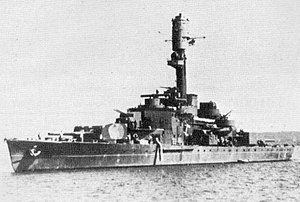Baltic Sea campaigns (1939–45)
| Baltic Sea campaigns (1939–1945) | |||
|---|---|---|---|
| Part of the Eastern Front of World War II | |||
 Finnish coastal defence ship Väinämöinen in 1938. |
|||
|
|||
The Baltic Sea Campaigns were conducted by Axis and Allied naval forces in the Baltic Sea, its coastal regions, and the Gulf of Finland during World War II. After early fighting between Polish and German forces, the main combatants were Germany and Finland, opposed by the Soviet Union. Sweden's navy and merchant fleet played important roles, and the British Royal Navy planned Operation Catherine for the control of the Baltic Sea and its exit choke point into the North Sea. While operations included surface and sub-surface combat, aerial combat, amphibious landings, and support of large-scale ground fighting, the most significant feature of Baltic Sea operations was the scale and size of mine warfare, particularly in the Gulf of Finland. The warring parties laid over 60,000 naval mines and anti-sweep obstacles, making the shallow Gulf of Finland one of the most densely mined waters in the world.
The Finnish Navy was a small professional force. Naval strength in 1941 consisted of:
The Finnish Navy used several other vessels (for example, Coast Guard vessels) during the wars:
Initially, the German Reichsmarine—the Kriegsmarine's pre-war name—suffered from the limitations imposed by post-World War I treaty obligations; by 1935, however, Germany had signed the Anglo-German Naval Agreement, which allowed it to expand considerably. The name Kriegsmarine was adopted the same year. Though a large, powerful, and professional force, it had to divide its assets between several theaters of war, severely limiting the number and size of the ships it was able to deploy in the Baltic Sea.
At the start of the Operation Barbarossa on 21 June 1941 German naval forces in the Baltic Sea consisted of
In September 1941 Germany formed the provisional Baltenflotte, which consisted of the battleship Tirpitz, cruisers Admiral Scheer, Emden, Köln, Leipzig and Nürnberg, destroyers Z25, Z26, Z27 and the 2nd torpedo boat squadron. It had been tasked with destroying the Soviet Baltic Fleet should it try to escape to neutral Sweden. As this did not happen, and aerial reconnaissance showed severe damage to the remaining ships of the Soviet Baltic Fleet, the Baltenflotte was disbanded before October 1941.
...
Wikipedia
